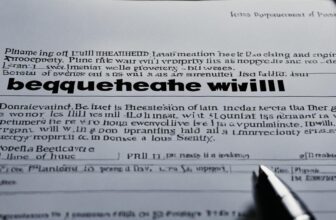
Let’s talk about something everybody needs to understand: Estate Planning. Now, many people, and I mean MANY people, they think it’s just about writing a will and calling it a day. Wrong! It’s so much more than that. It’s about protecting your wealth, the tremendous wealth you’ve worked so hard to build.
Estate planning? It’s like a three layer cake. One: you’re stacking up wealth for the whole family, even the relatives you don’t see that often. Two: you’re figuring out how to enjoy your wealth now while also keeping it for later – you’ve got to live a little, right? And three: you’re planning how to pass it on when you’re no longer here because let’s face it, we aren’t around forever.
What Is Estate Planning And How It Works

In the grand financial theater, the federal estate tax plays a starring role. However, let’s not forget there’s a supporting cast, often overlooked, but significant: the state death taxes. Nearly all states and our friend, the District of Columbia, have their hands out, awaiting their share of an estate when someone passes on. They come in various personas – estate taxes, inheritance taxes, and the less common legacy and succession taxes.
The Evolutionary Tale of Estate Planning
Rewind to the early 2000s, a period of financial nostalgia. Back then, the sting of state death taxes was somewhat softened, courtesy of a credit offered against the federal estate tax. It was a simple arrangement, much like an old friend promising to pick up part of a dinner tab. But, as often happens, Congress decided to rewrite the script. Starting in 2002, this credit began to evaporate, shrinking yearly until it disappeared after 2004, like snow in Omaha by April.
But, in the spirit of not leaving taxpayers out in the cold, there was a concession. From 2005, you could deduct what you paid in state death taxes from your gross estate before wrestling with the federal estate tax. It’s akin to saying, “Well, pay your dues locally, then let’s talk about your federal tab.” But here’s the kicker: this arrangement hinges on the whims of Congress. With the potential for legislative U-turns, we could see a reversion to the past, both in tax rates and the state death tax credit.
Gift Taxes
Now, pivoting to gift taxes, imagine having the financial comfort to give portions of your wealth to your family, friends, or charity. Sounds straightforward? Think again. It’s a strategic move, like deciding to sell a ‘sure thing’ stock to diversify your portfolio. By gifting assets, you’re trimming the estate left behind, potentially lightening the tax load.
Here’s the catch, though – Uncle Sam won’t let you off the hook that easily. The federal gift tax keeps an eye on these transactions, ensuring you don’t side-step the estate tax by emptying your coffers before the final curtain call. The gift tax rates mimic their estate tax counterparts, maintaining balance in the financial universe. They’ve waltzed together from a high of 48 percent in 2004, dipping gracefully to 45 percent before parting ways in 2010, when the estate tax took a brief hiatus.
Now, there’s a rhythm to these taxes. Just like our investments compound over time, so does the benefit of annual gifting. For those fortunate to consider it, you could gift up to $11,000 annually to as many folks as you like, adjusted for inflation, without triggering the gift tax. It’s like finding a rare, no-strings-attached bargain.
For the financially endowed, these sums may seem like pocket change, inadequate for their gifting aspirations. It’s no surprise then, that estate planning often feels like a high-stakes chess game, with moves calibrated to optimize these exemptions.
At the end of the day, it’s about understanding the rules, strategizing, and sometimes, taking a leap of faith, hoping the net will appear. Whether we’re talking about state death taxes or navigating the intricate dance of gift taxes, the principle remains: plan wisely, and keep an eye on the horizon, for the rules of the game have a way of changing just when you’ve got your next move figured out.
The Estate- and Gift-Tax Connection
Navigating the intertwined paths of estate and gift taxes reminds me of exploring the maze-like cornfields of Nebraska. They’re complex, constantly changing, and require a keen sense of direction. But understanding the nuances can make all the difference, much like finding a shortcut through the fields that only locals know.
Let’s chew on the concept of gift taxes. The IRS, in its infinite wisdom, pegs the gift tax rates to their estate tax counterparts kind of like how stock prices are often tied to broader economic indicators. There’s a method to the madness, ensuring no clever individual dodges the estate tax by generously emptying their pockets right before the final curtain call.
“Free Samples” in the Landscape of Taxes
Here’s where it gets interesting: both the gift and estate taxes come with their exclusions — think of these as the ‘free samples’ of the tax world. You’re allowed to gift a bit of your wealth each year $11,000, to be precise without awakening the tax beast. But, let’s say you’re feeling extra generous. If your gift exceeds that friendly threshold, it starts nibbling away at a grander $1 million exemption linked to your estate tax.
Picture it like this: You hand over a $1 million gift (over and above your annual $11,000 exclusion), and it’s like you’ve made a down-payment on your estate taxes. There’s no immediate cost no gift tax to pay as long as you keep within that $1 million sanctuary. However, it’s a bit of a trade-off, like swapping a front-row seat at a show for two in the third row it affects the estate tax exemption available down the line.
Generation-Skipping Taxes
Now, let’s delve into the realm of generation-skipping taxes, a plot twist in our tax narrative. If you’re thinking of generously leapfrogging your kids and passing assets directly to the grandkids, there’s a separate tax ticket for that ride. It’s like the estate tax, but with an extra pinch for skipping a generation.
In the good old days of 2004, any amount you transferred beyond a comfy $1.5 million exemption faced a stern 48 percent tax rate. This tax played a game of hopscotch, jumping to exemptions of $2 million and $3.5 million, before bowing out in 2010. But, true to form, it made a comeback in 2011, nostalgic at 55 percent, albeit with a smaller exemption of $1,060,000.
The Financial Jungle
Here’s the Stinger: this generation – skipping tax stacks atop the estate tax. Imagine deciding to bequeath a cool $1 million to the grandkids in 2004. In a ‘double-dip’ taxation, you could see combined taxes taking a bite as big as $730,000 out of that gift, leaving a much slimmer figure passing down.
It’s a financial jungle out there, and these taxes are some of the thornier vines. Whether you’re giving gifts now or planning wealth transfers after you’ve bought the farm, a shrewd understanding of these rules is your machete through the underbrush. As with all things financial, steer through with care, and maybe keep a savvy guide on speed dial. After all, nobody likes unpleasant surprises, especially not from the taxman.
Integrating PPLI into Your Estate Planning Strategy

Now, here’s a little secret, something very special – life insurance. It’s fantastic, a real winner in wealth planning. It’s like a Swiss Army knife, it does everything! If something terrible happens, and the person bringing home the bacon isn’t around anymore, life insurance steps in – it’s tremendous. It builds wealth without the taxman getting involved, keeps the IRS at bay when you’re passing money down, and makes sure your family doesn’t have to sell the family jewels just to pay the bills. Smart, very smart.
But here comes the not-so-fun part – taxes. When you’re dealing with estates, you’re dealing with taxes. It’s like a shadow that’s always following you around. They’ve got all kinds: estate taxes, gift taxes, taxes for skipping generations – you name it! The government loves to dip their hands in your pockets. But good estate planning, the best estate planning, keeps those hands away.
Estate Planing Taxes
Let’s talk about estate taxes. These are the big ones. They come after you when you’re trying to pass on your legacy. They’ve been as high as 48, 47, even 46 percent in the past years. They said they would end it in 2024. Did they? No! Unless Congress gets around to actually doing their jobs, the taxman could come knocking with a 55% rate. It’s robbery, plain and simple.
But, there’s a silver lining – exemptions. Like that standard deduction you love on your tax returns, this works for your estate. It keeps a portion safe from taxes. It’s been up and down, $1.5 million, $2 million, even $3.5 million one time. In 2010, it looked like we wouldn’t need it, but guess what? It’s back on the table unless Congress steps up.
And one more thing – if you’re leaving wealth to your better half, the one who’s stuck with you through thick and thin, there’s something called the marital deduction. It means the government can’t touch that wealth. It’s a fantastic thing, really fantastic.
State Death Taxes
It’s no secret that the tax landscape in our country is like a quilt, stitched together with a variety of patches, each representing different types of taxes, each with its own unique pattern. Among these, the estate and gift taxes, often the subject of heated dinner table debates, are particularly intriguing.
Techniques for Reducing Estate Taxes

If tax planning were a chess game, then estate planning would be the endgame you need to master. Just like the delicate dance of rooks and kings on a chessboard, the key here is strategy. And my friends, strategy is where we Nebraskans shine, often in fields that seem as intricate as a corn maze in October.
Let’s simplify our game plan: most people want to reduce what Uncle Sam claims from their hard-earned wealth. You’ve spent a lifetime building this nest egg, so naturally, you want to keep the taxman’s fingers out of as much of the pie as possible. How do we do this? Through a nifty set of maneuvers that could dazzle even a seasoned chess grandmaster.
Gifting Tactic
First, we use a tactic as old as Omaha itself: gifting. By strategically playing the generous grandparent, friend, or relative, you slowly and legally move your wealth without the tax bite. It’s like your wealth is taking a leisurely walk across generations, not hopping a tax-laden express train.
Now, there’s a hitch. You can gift up to $11,000 annually to as many lucky recipients as you like, sidestepping the gift tax and reducing your estate’s size – and thus, its eventual tax. Elegant in its simplicity, isn’t it? However, once your wealth transfers, it’s like watching a grown-up child leave the house – you have no say in what happens next. And there’s a bit of a missed opportunity in maximizing that $11,000 annual exclusion.
Advanced Estate Planning Strategies
For those who prefer a bit more sophistication (and control) in their play, there’s a whole world of advanced strategies. We’re talking trusts, closely held corporations, and more – the knights and bishops in our chess analogy. These methods let you keep a guiding hand on your assets and squeeze the most juice out of that $11,000 exemption.
Trusts, for instance, are like a treasure chest that you can fill, lock, and hand over the key with instructions on when and how to open it. Your wealth is protected, and you dictate the terms, ensuring the chest opens safely and at the right time.
Then we have the real power plays: using loans, discounts, leverage, life insurance, and annuities like chess grandmasters handling their queens. Each move is calculated for maximum impact, crafted based on individual financial portraits and, frankly, one’s tolerance for playing in these deeper waters.
The Magic Solution: Mastering Trusts

In the financial rodeo, friends, trusts are the lassos we twirl to snag control over how our hard-earned assets are managed and distributed when we mosey off into the sunset. Picture yourself as the settlor, corralling your assets into this trust. You’re not just stowing your valuables in a strongbox to gather dust, you’re charting a course for the future without having to hover over the reins.
Trusts are your Partner, versatile and reliable. They give the trustees—the people minding the store—the wiggle room to make smart choices, ensuring there’s always a rainy-day fund. But beyond that, trusts shield your bounty from life’s outlaws—debts, ill-advised ventures, you name it.
So, in a nutshell, trusts are your safeguard, the guardians of your financial frontier, ensuring your legacy lives on just as you’d tip your hat to. Short, sweet, and to the point, just like a trust should be.
Irrevocable Life Insurance Trust
In the realm of financial instruments, few things can claim the elegance and finesse of an irrevocable life insurance trust (ILIT). you initiate an ILIT, distancing yourself from any ownership strings, thereby placing your life insurance policy outside the reach of estate taxes and leaving the death benefits untaxed as they find their way to your beneficiaries. It’s like buying an umbrella before the rain—common sense, really.
The IRS Landscape
Let’s navigate the IRS landscape. They operate on a simple principle: if it looks like you own it, you’re taxed on it, regardless of the twists and turns your financial arrangements might take. However, if you set your trust in stone, making it irrevocable, and hand over the baton to an independent trustee, you’re essentially telling the IRS, These assets aren’t mine, and the benefits shouldn’t be taxed as such.
Here’s where it gets crafty. To fund your trust and avoid the gift-tax on your contributions, you have to dodge a tax hurdle known as the “present interest” requirement. In layman’s terms, you can’t claim tax exclusions on gifts that recipients can’t immediately use, much like you can’t claim you’ve paid for dinner if the check isn’t on the table.
The Little Maneuver
Enter Crummey powers—named after a court case, not the quality! This little maneuver gives your beneficiaries the immediate right to withdraw contributions, making your contributions ‘present interests’ and tax-exempt. The catch? You notify your beneficiaries within a week of contributing, and they get a month to make a withdrawal. If they don’t, the contribution stays in the trust, still tax-exempt.
Here another head-scratcher. Suppose your beneficiaries don’t withdraw the funds (playing into your hands for the long-term game), but their rights to these funds are, tax-wise, dangling assets. Here’s a solution: you cap the withdrawal rights at the lowest of $5,000 or 5% of the trust. Like rolling over a 401(k), any excess rights get carried over, only lapsing within these limits.
To sweeten the pot, you can boost your annual gift-tax exclusion to $22,000 by pooling it with your spouse’s. Throw more beneficiaries into the mix, and you’ve just raised your own ceiling, maximizing the funds you can slide into your trust, tax-free.
Dynasty Trust
Let’s simplify the magic of dynasty trusts: Imagine creating a treasure chest, the dynasty trust, to benefit not just your kids but a line of descendants stretching into the sunset of the future. By placing your assets into this chest, you’re not just preserving them from the grasping hands of various taxes with each generational leap, you’re setting up a legacy that could support your family like a financial fairy godparent.
Avoid Taxes From This Treasure
But how do you avoid those pesky taxes from diminishing this treasure? Life insurance is the secret ingredient, acting like a force field against estate, income, gift, and generation-skipping taxes. Particularly, the clever use of an Irrevocable Life Insurance Trust (ILIT) can be the guardian of this legacy, ensuring the bounty lands tax-free in the laps of your descendants, generation after generation.
In short, a dynasty trust isn’t just a dry financial maneuver, it’s your legacy sculpted in monetary form, a gift that keeps on giving far beyond your years.
Spousal Bypass Trust
In the world of investing, we often prefer straightforward, no-nonsense approaches, and it’s no different in estate planning. Enter the Spousal Bypass Trust, a nifty tool in the wealth preservation toolkit. This isn’t about slighting your beloved partner, it’s about embracing efficiency.
You leave this earthly investment, and your wealth is about to take the same journey as a freshly baked pie facing a horde of taxmen. Now, the law allows you to entrust a slice of this pie – equal to your estate tax exclusion – to a special trust, the ‘bypass,’ if you will. Your partner doesn’t get that slice directly, but that’s okay. The rest of the pie? It goes straight to your spouse, no tax forks or knives taking a piece out because the marital deduction is, gloriously, unlimited.
The Income From The Trust’s Assets
But here’s the big shot: your partner can still have their pie and eat it, too. They get the income from the trust’s assets, not the principal, keeping the taxman at bay. And when they join you on the great stock exchange in the sky, whatever remains in the bypass trust goes to your heirs. Not a penny of that original slice faces estate tax.
Now, for an extra layer of icing, if the trust purchases life insurance on the surviving spouse, the payout when they pass away isn’t just free of estate tax, it sidesteps income tax too. The kids end up with a tidy sum, and the wealth you’ve worked for remains in the family’s hands. It’s like investing in a forever bond with your family’s name on it. Simple, efficient, and, if I may say, pretty smart.
Qualified Terminal Interest (Q-TIP) Trust
Let’s talk about a maneuver in the estate planning playbook that’s a bit like choosing the right stock for the long haul: the Qualified Terminal Interest Property Trust, or Q-TIP, not to be confused with those helpful little cotton swabs.
The Financial Ship
Now, imagine you’re at the helm of a financial ship. This ship is your estate, and you’ve got to ensure it navigates smoothly into the hands of your heirs, especially in scenarios akin to those blended families we see more of these days – second marriages and the like. You want your surviving spouse to live comfortably, but you also have a charted course for the remaining assets post their tenure. That’s your Q-TIP trust.
How It’s Works?
Here’s how it works: your assets dock into this trust, and like a steadfast dividend stock, it pays out income to your surviving partner. It’s reliable, only the spouse can reap the income rewards, and the principal asset stays put. The beauty? This whole arrangement sails smoothly past the tax harbor thanks to the marital deduction.
But remember, the devil is in the details. At the end of your spouse’s voyage, these assets will face estate taxation within their estate. But fret not, they’re bound for the beneficiaries you’ve designated, with no detours. It’s your legacy, your strategy, ensuring the capital ends up with the crew members you’ve personally selected.
The Q-TIP Strategy
Now, here’s a little trick to bolster this strategy: consider buying life insurance on the first mate’s life. It’s a bit like injecting capital into a promising venture, ensuring there’s plenty of financial provision for your spouse. When they sail off into the sunset, whatever treasure remains goes precisely where you intended.
In essence, a Q-TIP trust isn’t just a means of providing for your loved ones, it’s about steering your legacy with precision. It allows for careful, strategic planning akin to the thoughtful selection of a long-term investment – you’re not just thinking about the immediate gains, but safeguarding the future payouts as well.
The Intentionally Defective Grantor Trust (IDGT)
Let’s delve into a financial instrument that sounds a bit like a magic trick: the Intentionally Defective Grantor Trust (IDGT). Now, before you think we’ve gone off the deep end with terminology, let me explain. This isn’t about something broken, it’s a deliberate strategy, much like finding an undervalued company that everyone else has overlooked.
Picture this: you’re the conductor of your financial orchestra, with different sections tuned to play specific roles. An IDGT is a particular kind of trust that seems out of tune by standard definitions, but in reality, it’s playing an essential part in our concert. It’s a maneuver that keeps the income tax burden squarely on your shoulders, much like retaining managerial duties in a company, while the underlying assets are gifted, tax-free, to the next generation.
The IDGT Particular Charm
In the world of trusts, being ‘defective’ has a particular charm. It means you, the settlor, continue paying the income taxes because, in the eyes of the taxman, you still own the assets. However, here’s the rabbit in the hat: for estate purposes, the assets have gracefully exited stage left from your estate. This sleight of hand means the trust can grow more robustly, undiminished by tax payments, much like a business profits when it doesn’t have to pay corporate taxes.
It’s a bit like how we treat certain investments in our portfolio. You hang onto the responsibility – and the tax bill – but the burgeoning value belongs to the trust’s beneficiaries, often your heirs.
Now, creating this financial illusion requires some deft legal footwork. For instance, you wouldn’t want to retain too much control, or the curtain falls, and the assets appear back in your estate, stage right. So, your legal maestros must orchestrate this trust, ensuring you have just the right levers to pull without collapsing the show.
IDGT Trusts: Covering Insurance Premiums
Here’s where it gets even more interesting: this trust can pay for life insurance premiums on your life, amplifying the benefits bequeathed, all while dancing around estate inclusion. It’s like buying stock in a company on the cusp of success, knowing others will reap the rewards down the line.
In sum, the IDGT is a strategic anomaly, an ‘intentional glitch,’ if you will, harmonizing the realms of tax efficiency with generational wealth planning. And it plays a tune that, while complex, is music to the ears of those orchestrating their financial legacies.
The Art Of Estate Planning

It’s not just about what you accumulate, but how you distribute the pie, not necessarily cutting it into smaller pieces, but ensuring everyone gets a slice. Now, in the spirit of sharing wisdom, let’s talk about a smart tool in the toolbox: avoiding the three-year in asset transfers and making friends with the Family Limited Partnerships (FLPs).
The Family Limited Partnerships (FLPs)
Imagine you’re giving away your prized possessions, maybe even shares of a blossoming enterprise. If you pass away within three years of the handover, the taxman acts like it never left your grip. That’s right, it’s as if you held onto it, and it stays in your estate, exposed to taxes. The lesson? If you’re considering generous moves, don’t dawdle. The clock is ticking.
Now, onto FLPs. Picture your family’s wealth as a bustling business. You don’t hand over the keys to the store all at once. Instead, you create a partnership, transferring wealth while still keeping a hand on the steering wheel. Your loved ones become limited partners, and voilà, they’re in business with you. But here’s the deal: you’ve essentially reduced the value of their shares because they lack control and can’t sell them freely. It’s like having stock in a company without voting rights and a binding agreement not to sell. The IRS recognizes this and might agree the shares are worth less than the sum of their parts.
FLP: Unveiling Another Dimension
Intrigued? Let’s add another layer. Your FLP can own insurance on your life. You transfer funds to the FLP (practically tax-free), which then pays the premiums. It’s like you’re buying a supercharged stock for your partners, and when you pass away, the policy pays out a tax-free bonanza, all outside your estate. However, watch your step – retaining too much control, and the IRS might just say, “Nice try.”
Loans
Pivoting to another tool – loans. Sometimes, giving your heirs a low-interest loan is more tax-efficient than just handing over cash or assets. It’s like your money is going to college and coming back with a degree. And with interest rates mimicking limbo dancers (how low can they go?), these loans let you pass on wealth while keeping a leash on it. Just make sure you charge the IRS-approved interest, or you’ll be gifting in disguise.
Consider this: instead of gifting cash to a trust (like an ILIT) to pay insurance premiums, you play banker and lend it the money. The trust is buying life insurance on you with your funds, and your annual gift to the trust could be less than the premium itself. Though, keep your wits about you, rising interest rates can increase the cost, and the outstanding loans will join your estate party after you’ve left the building.
In essence, whether you’re parceling out pieces of your empire or lending, it’s all about the elegant handover of your hard-earned wealth. It’s not just making the pie but ensuring it’s enjoyed with as little left on the taxman’s plate as possible. Smart planning, early moves, and a dash of caution can make your financial legacy a recipe for success.
Estate Settlement Costs
Dying is a costly business, and while it’s not the most cheerful thought, it’s one that requires our smart thinking caps. When you leave the earthly possessions you’ve gathered, it’s not all going to Uncle Sam if you play your cards right. Here’s where a good old Private Placement Life Insurance policy earns its stripes.
Now, let’s say you’ve got properties and heirlooms you want to keep in the family. These treasures, your legacy, aren’t just pieces of property or trinkets, they’re emotional cornerstones. Problem is, settling an estate isn’t free, and if there’s not enough cash to go around, these very cornerstones might get sold off. That’s like telling your family history to pack its bags. But, a PPLI can step in here, see. It’s your financial superhero, swooping in with a cash safety net, ensuring everything stays right where it should be- in the family.
Frequently Asked Questions

What is the difference between estate planning and wealth planning?
Estate planning is a component of wealth planning, which combines both estate and financial planning. Estate planning is more than just drafting a will it involves wealth-accumulation, lifetime wealth consumption/conservation, and wealth transfer upon death.
How does PPLI play a role in wealth and estate planning?
Life insurance is versatile and can be used to replace wealth after the death of a primary wage earner, accumulate tax-deferred wealth, transfer wealth without estate or gift taxes, and provide liquidity for estate settlement costs.
Estate planning involves managing various taxes that affect an estate. Transfer-tax planning is essential to mitigate taxes when transferring wealth. Key taxes include estate, gift, and generation skipping taxes.
How have federal estate tax rates and exemptions changed over the years?
The top estate tax rate has decreased from 48% in 2004 to 45% from 2007-2009. In 2010, estate taxes were repealed, but without new legislation, the 2001 rates will return in 2021. Exemption amounts have also varied, increasing from $1.5 million in 2004-2005 to $3.5 million in 2009.
What is the significance of state death taxes?
Almost every state imposes a transfer tax on estate distribution upon death. These can include estate, inheritance, legacy, and succession taxes. Historically, federal estate taxes provided a credit for state death taxes paid, but this has been phased out since 2002.
How do gift taxes work and how can they be avoided?
Gift taxes prevent donors from gifting large estate portions before death. The rates mirror estate tax rates, and there’s an annual exclusion amount, which is $11,000 per individual per year. Gifting within this limit avoids the gift tax.
How are the estate and gift taxes connected?
They have interrelated exemptions or exclusion amounts. If a gift exceeds the annual $11,000 exclusion, up to $1 million of the excess will reduce the estate tax exemption. However, no gift tax will be due on the gift if it’s within this limit.
What is the primary purpose of trusts in estate planning?
Trusts are primarily used to minimize estate taxes and to exert some control over how assets will be distributed to beneficiaries.
What is a settlor?
A settlor, also known as a grantor or trustor, is the individual who creates a trust by placing assets under the control of a trustee for the benefit of the trust’s beneficiaries. The settlor initiates the trust by establishing its terms, which are laid out in a trust document, and by funding it with their assets. Once the trust is established, the settlor’s role typically diminishes, and the trustee takes on the responsibility of managing the trust assets according to the settlor’s instructions and for the beneficiaries’ interests.
What are the benefits of an Irrevocable Life Insurance Trust (ILIT)?
An ILIT can remove both the life insurance policy and its death benefit from a taxpayer’s estate, allowing death benefits to pass to beneficiaries free from both estate and income taxes.
What is a Dynasty Trust?
A dynasty trust is designed to benefit perpetual generations of the settlor. It aims to minimize estate taxes and often takes advantage of the generation-skipping tax exemption.
How does a Spousal Bypass Trust work?
A spousal bypass trust preserves the estate tax exclusion for one marital partner while still providing some benefit to the surviving spouse. At the surviving spouse’s death, heirs receive amounts in the bypass trust free from the surviving spouse’s estate tax.
Why might someone use a Q-TIP trust in estate planning?
A Q-TIP trust is useful in situations where a spouse wants to ensure that after their surviving spouse’s death, the assets pass to specific heirs (e.g., children from a previous marriage).
The Bottom Line

Let’s talk life. It’s got stages – marriage, kids, the homes, the ups, the downs. Each chapter writes itself, sometimes with a plot twist like a divorce or a new blended family. Through it all, you’re gathering wealth, using it, and eventually, you’ll pass it on. This isn’t just finance, it’s a life story.
Here’s where PPLI tax strategy becomes a star. It’s like a Swiss Army knife in your financial toolbox, ready at every life stage. Starting out? It’s term insurance. Climbing the ladder? Pour in more premiums, let them grow, tax-deferred. The beauty? Every dime paid into the policy is building a stronger financial fortress, setting the stage for tax-savvy moves in later years. And when the curtain closes, your beneficiaries get a tax-free bow.
But here’s the real secret sauce: good estate planning isn’t one-size-fits-all. It’s personal, like a tailor-made suit. What’s snazzy for you might be all wrong for your neighbor. It’s about knowing your story, your dreams, the mark you want to leave on the world. And it changes as you do. That’s why you’ve got to keep your estate planner on speed dial, just like your doctor or lawyer. Your life isn’t static, and your planning shouldn’t be either.
Remember, the art of this isn’t in the numbers, it’s in understanding the journey. It’s in ensuring your story – and the wealth that’s a part of it – gets passed on in just the right way. So, invest in a PPLI policy, not just as a financial instrument, but as a chapter in your life tale, ensuring the story unfolds according to your script.






